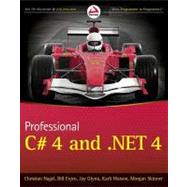
| Introduction | |
| The C# Language | |
| .NET Architecture | |
| Core C# | |
| Objects and Types | |
| Inheritance | |
| Generics | |
| Arrays and Tuples | |
| Operators and Casts | |
| Delegates, Lambdas, and Events | |
| Strings and Regular Expressions | |
| Collections | |
| Language Integrated Query | |
| Dynamic Language Extensions | |
| Memory Management and Pointers | |
| Refl ection | |
| Errors and Exceptions | |
| Visual Studio | |
| Visual Studio 2010 | |
| Deployment | |
| Foundation | |
| Assemblies | |
| Instrumentation | |
| Threads, Tasks, and Synchronization | |
| Security | |
| Localization | |
| System.Transactions | |
| Networking | |
| Windows Services | |
| Interop | |
| Core XAML | |
| Managed Extensibility Framework | |
| Manipulating Files and the Registry | |
| Data | |
| Core ADO.NET | |
| ADO.NET Entity Framework | |
| Data Services | |
| Manipulating XML | |
| .NET Programming with SQL Server | |
| Presentation | |
| Core WPF | |
| Business Applications with WPF | |
| Creating Documents with WPF | |
| Silverlight | |
| Windows Forms | |
| Core ASP.NET | |
| ASP.NET Features | |
| ASP.NET Dynamic Data and MVC | |
| Communication | |
| Windows Communication Foundation | |
| Windows Workfl ow Foundation 4 | |
| Peer-to-Peer Networking | |
| Message Queuing | |
| Syndication | |
| Appendix: Guidelines for Windows 7 and Windows Server 2008 R2 | |
| Index | |
| Online Chapters | |
| Graphics with GDI+ | |
| Visual Studio Tools for Office | |
| Managed Add-In Framework | |
| Enterprise Services | |
| Directory Services | |
| C#, Visual Basic, C++/CLI, and F# | |
| .NET Remoting | |
| Web Services with ASP.NET | |
| LINQ to SQL | |
| Windows Workfl ow Foundation 3.0 | |
| Table of Contents provided by Publisher. All Rights Reserved. |
The New copy of this book will include any supplemental materials advertised. Please check the title of the book to determine if it should include any access cards, study guides, lab manuals, CDs, etc.
The Used, Rental and eBook copies of this book are not guaranteed to include any supplemental materials. Typically, only the book itself is included. This is true even if the title states it includes any access cards, study guides, lab manuals, CDs, etc.